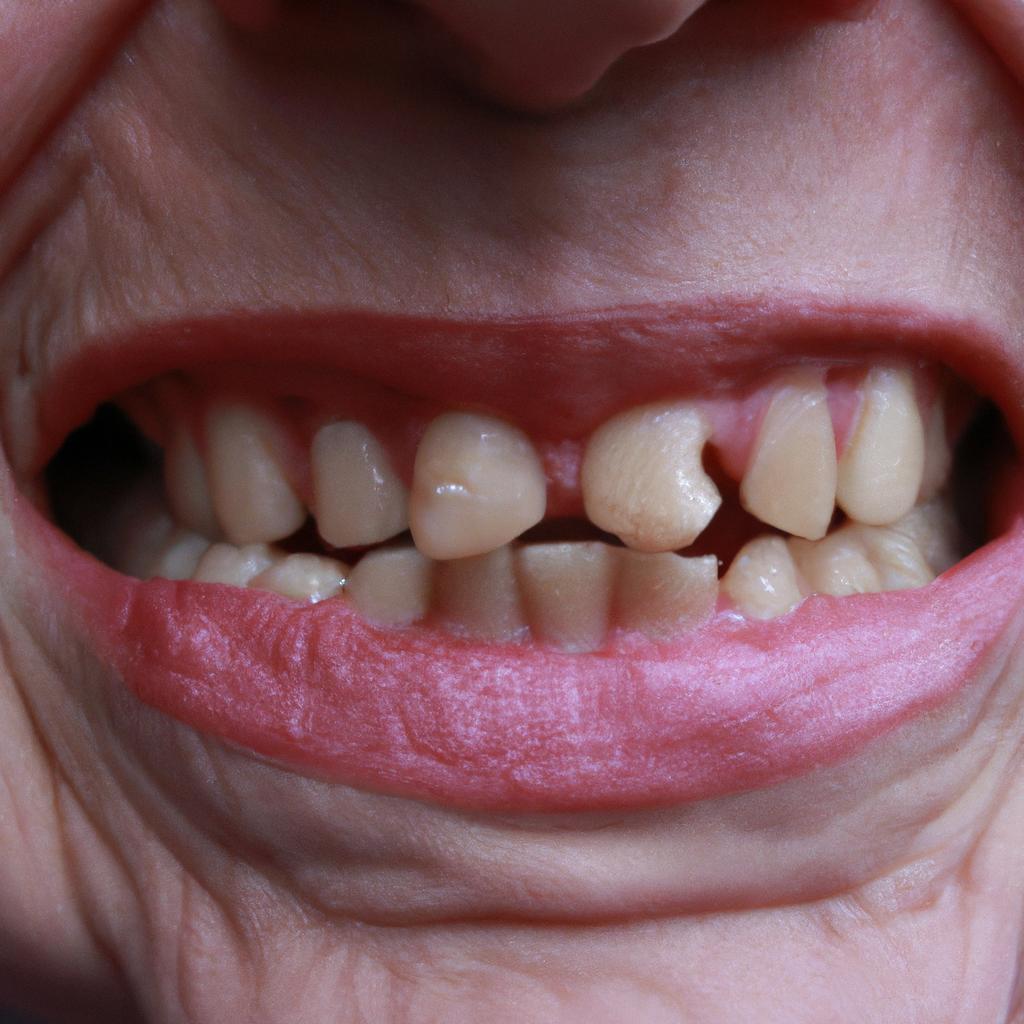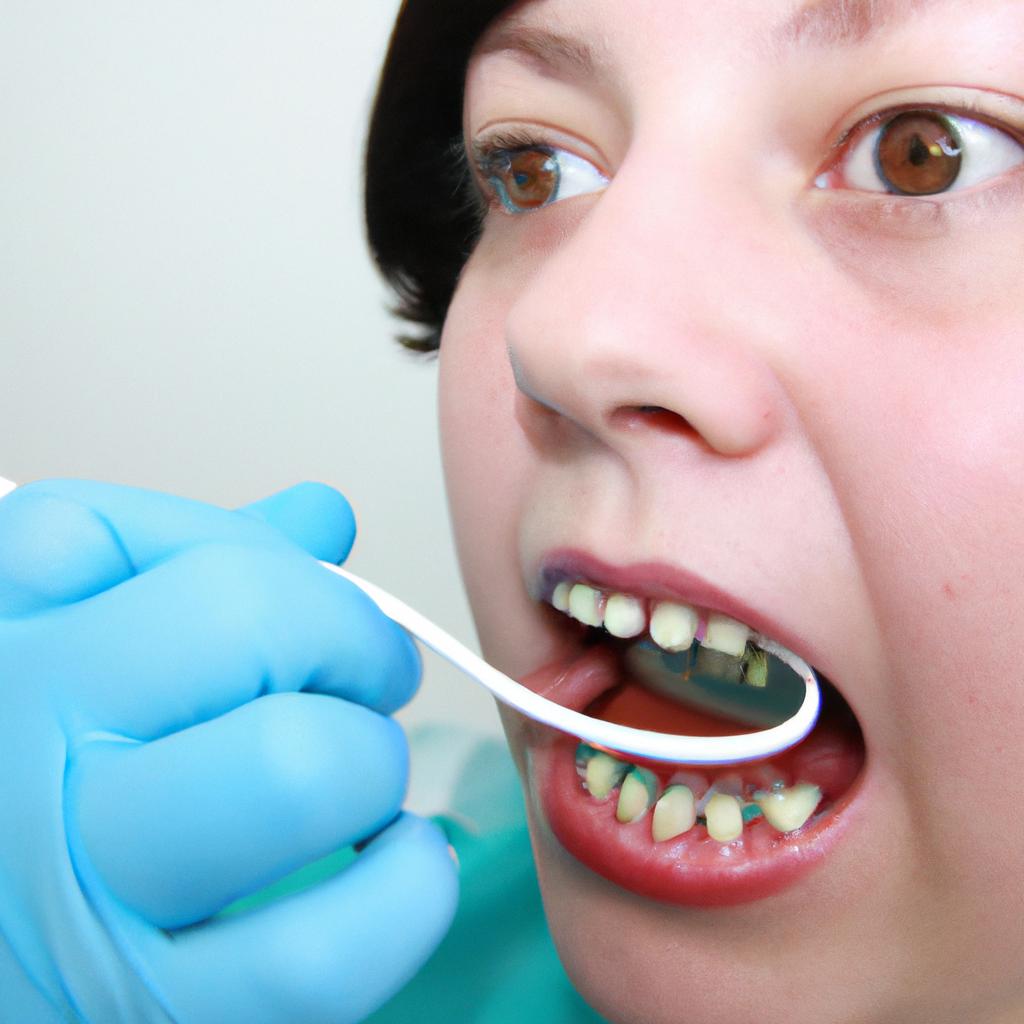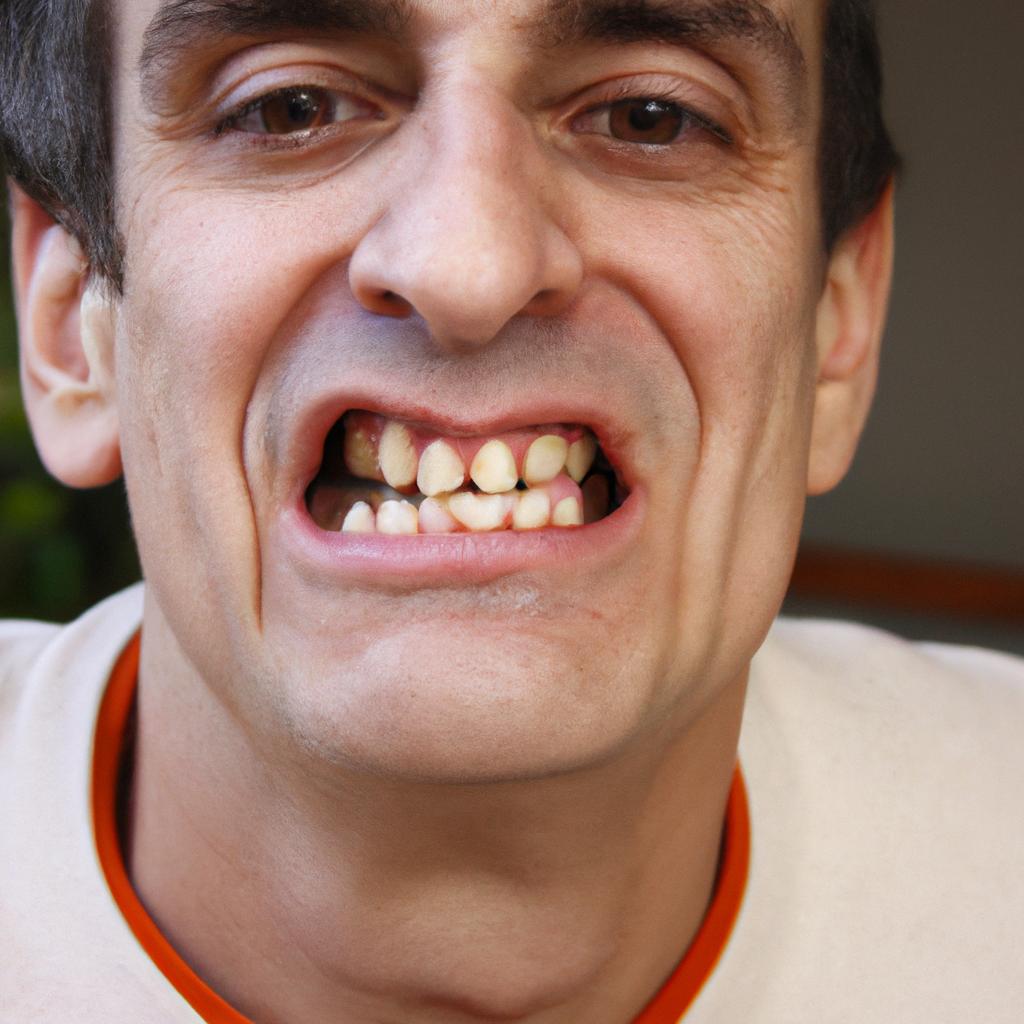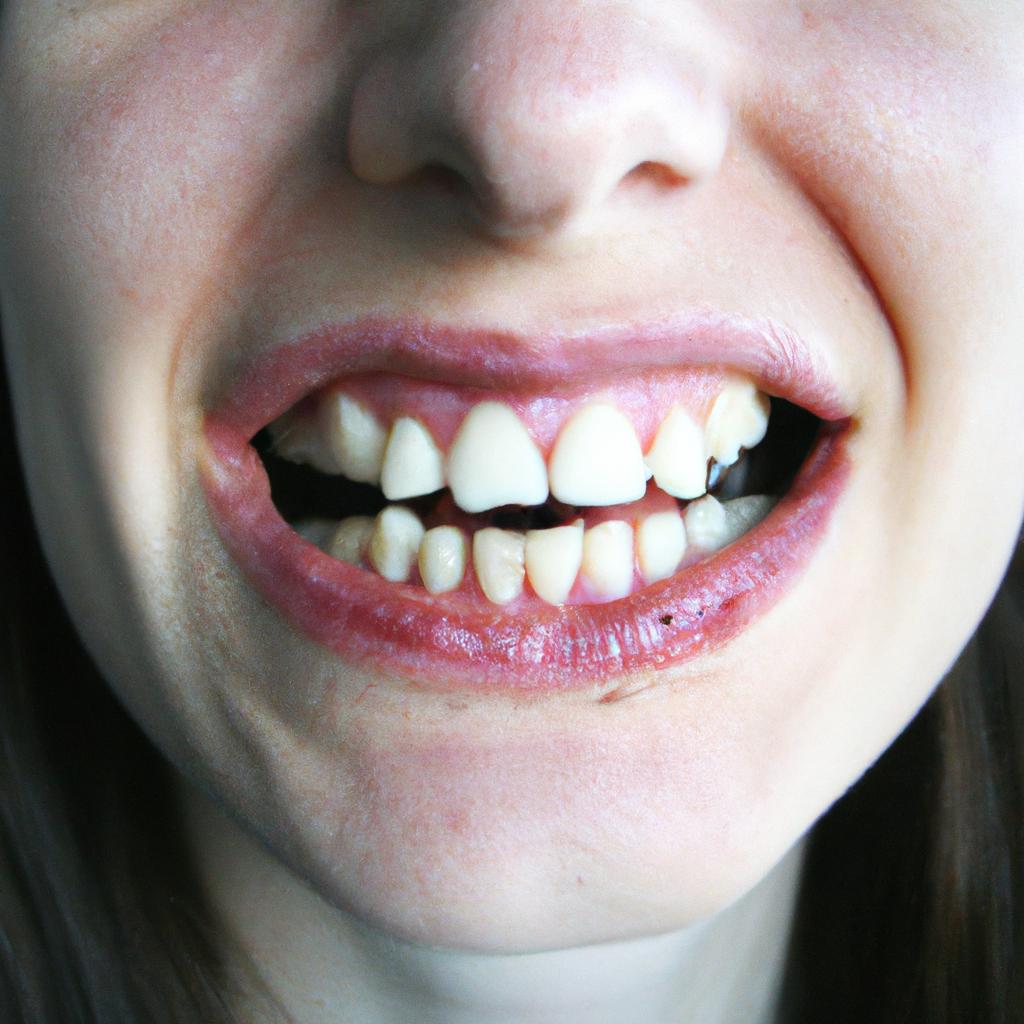Removable Partial Dentures in Prosthodontics: An Informative Guide

Introduction
Removable partial dentures (RPDs) play a crucial role in prosthodontics, offering an effective and affordable treatment option for patients with missing teeth. Whether it be due to trauma, decay, or periodontal disease, the loss of natural teeth can significantly impact a person’s oral health and overall well-being. For instance, consider the case of Mr. Johnson, a 55-year-old patient who lost several posterior teeth due to extensive caries. As a result, his ability to chew was compromised, leading to poor nutrition and diminished self-esteem. The use of RPDs provided Mr. Johnson with a viable solution by restoring his masticatory function and improving his quality of life.
This article aims to provide an informative guide on removable partial dentures in prosthodontics, addressing their design principles, materials used, clinical indications and contraindications, as well as maintenance considerations. Through examining current evidence-based practices and drawing upon scholarly research in the field of prosthodontics, this guide seeks to enhance our understanding of RPDs’ efficacy as a treatment modality for partial edentulism. By exploring various aspects such as biomechanical factors influencing RPD success rates and advancements in dental material technology , we can gain valuable insights into the optimal utilization of RPDs in clinical practice.
Design Principles
The design of a removable partial denture plays a critical role in its success and patient satisfaction. Several key factors must be considered during the design process to ensure proper fit, stability, and function. These include:
-
Framework Design: The framework serves as the foundation for the RPD and should be designed to distribute occlusal forces evenly across the remaining natural teeth and supporting structures. It is essential to consider factors such as material selection, esthetics, ease of cleaning, and patient comfort when designing the framework.
-
Retention and Stability: Adequate retention and stability are crucial for the success of an RPD. Various methods can be employed to achieve this, including clasps, rests, and indirect retainers. The choice of retention elements depends on factors such as tooth morphology, location within the arch, and patient preference.
-
Biomechanical Considerations: Understanding biomechanical principles is vital when designing an RPD. Forces exerted during mastication must be distributed evenly to prevent excessive stress on abutment teeth or soft tissues. Proper distribution of forces can help minimize complications such as tooth mobility or tissue irritation.
Materials Used
RPDs are fabricated using various materials chosen based on their specific properties and clinical indications:
-
Metal Alloys: Historically, cast metal alloys like cobalt-chromium have been widely used due to their strength and durability. They offer excellent retention properties and precise fit but may require additional laboratory procedures for fabrication.
-
Acrylic Resins: Acrylic resin-based RPDs are cost-effective and easily adjustable chairside. However, they may exhibit higher wear rates compared to metal frameworks and have limited longevity.
-
Flexible Materials: Flexible partial dentures made from materials like nylon are gaining popularity due to their esthetics, comfort, and ease of insertion. They provide a viable alternative for patients who may be allergic to metal or have aesthetic concerns.
Clinical Indications and Contraindications
RPDs are indicated in cases of partial edentulism, where there is an adequate number of remaining natural teeth to support the prosthesis. However, certain clinical situations may present contraindications for RPDs, including:
-
Poor Oral Hygiene: Patients with inadequate oral hygiene practices may not be suitable candidates for RPDs due to the increased risk of plaque accumulation and subsequent periodontal disease.
-
Unfavorable Tooth Morphology: Teeth with significant caries, extensive restorations, or compromised periodontal support may not provide sufficient stability for an RPD.
-
Severe Parafunctional Habits: Patients with severe bruxism or clenching habits may exert excessive forces on the RPD framework, leading to accelerated wear, fractures, or displacement.
Maintenance Considerations
Proper maintenance is crucial to ensure the longevity and functionality of an RPD. Patients should be educated on the following maintenance considerations:
-
Daily Cleaning: Removable partial dentures should be cleaned thoroughly using a soft toothbrush and non-abrasive denture cleansers after each meal. This helps prevent plaque accumulation and maintain oral hygiene.
-
Regular Check-ups: Patients should undergo regular dental check-ups to assess the fit and condition of their RPDs. Adjustments or repairs can be made if necessary.
-
Storage: When not in use, RPDs should be stored in a clean container filled with water or denture cleaning solution to prevent drying out and deformation.
Conclusion
Removable partial dentures remain an essential treatment option for patients with partial edentulism. By considering design principles, choosing appropriate materials, understanding clinical indications and contraindications, as well as emphasizing proper maintenance, clinicians can optimize the success rates of RPDs. Further research and advancements in prosthodontics continue to enhance the efficacy and patient satisfaction associated with removable partial dentures, ultimately improving the quality of life for individuals affected by partial edentulism.
Types of Removable Partial Dentures
Introduction
Imagine a patient, let’s call her Sarah, who has lost several teeth due to severe dental decay. As a result, Sarah experiences difficulty in chewing and speaking properly, which affects her overall quality of life. In such cases, removable partial dentures can be an effective solution to restore the function and aesthetics of the missing teeth. This section will explore different types of removable partial dentures commonly used in prosthodontics.
Partial Acrylic Denture
One type of removable partial denture is the acrylic denture. It consists of pink-colored acrylic resin that simulates gum tissue and artificial teeth made from composite materials or porcelain. Acrylic dentures are cost-effective and relatively easy to fabricate. However, they may lack durability compared to other options available. Despite this drawback, acrylic dentures provide satisfactory aesthetic results for patients like Sarah.
Metal Framework Denture
Another option for removable partial dentures is the metal framework denture. These prostheses combine a cast metal frame with artificial teeth attached to it. The metal framework provides stability and strength while allowing for a more precise fit than acrylic alternatives. Metal framework dentures offer enhanced longevity and resistance to wear over time, making them suitable for patients seeking long-term tooth replacement solutions.
Flexible Denture
In recent years, flexible partial dentures have gained popularity as an alternative choice. These dentures are constructed using thermoplastic materials that adapt well to changes in mouth shape during insertion and removal processes. Their flexibility ensures improved comfort by minimizing pressure on adjacent natural teeth and gums. Additionally, flexible dentures exhibit excellent esthetics due to their translucent appearance that closely resembles natural gingival tissues.
- Enhanced self-confidence through restored smile
- Improved ability to chew food comfortably
- Regained speech clarity leading to better communication
- Increased overall satisfaction with one’s appearance
Emotional Response – Table:
| Type of Denture | Advantages | Disadvantages |
|---|---|---|
| Partial Acrylic | – Cost-effective | – Less durable than other options |
| – Satisfactory aesthetics | ||
| Metal Framework | – Increased stability and strength | – More expensive than acrylic dentures |
| – Precise fit | ||
| Flexible | – Excellent comfort | – Requires specific cleaning procedures |
| – Translucent appearance resembling natural gums |
In summary, the use of removable partial dentures offers an array of benefits for patients like Sarah. The choice between different types of dentures depends on individual preferences, budget considerations, and clinical factors such as oral health condition and degree of tooth loss. In the subsequent section, we will delve into the indications for removable partial dentures, exploring when they are most commonly recommended.
Understanding the various types of removable partial dentures sets the foundation for determining their appropriate use in specific cases. Now that we have explored these options comprehensively, let’s move forward to discuss the indications for removable partial dentures.
Indications for Removable Partial Dentures
In the previous section, we explored the various types of removable partial dentures commonly used in prosthodontics. Now, let us delve into the indications for their use and how they can benefit patients.
Indications for Removable Partial Dentures:
To illustrate the importance of removable partial dentures, consider a hypothetical case study: Mr. Johnson, a 55-year-old individual who lost three molars due to decay. These missing teeth not only affected his ability to chew properly but also impacted his self-confidence when speaking or smiling. In such cases, removable partial dentures offer an effective solution by replacing the missing teeth and restoring oral function and aesthetics.
When determining whether a patient would benefit from removable partial dentures, several factors come into play. These include:
- Number and location of missing teeth: Removable partial dentures are suitable for individuals with one or more missing teeth in different areas of the mouth.
- Bone quality and quantity: Sufficient bone support is necessary to ensure stability and retention of the denture.
- Oral hygiene maintenance: Patients must demonstrate good oral hygiene practices to prevent complications that could arise from wearing removable partial dentures.
- Patient preferences: The individual’s willingness and commitment to using removable partial dentures should be considered when assessing their suitability as a treatment option.
Let us now briefly explore these indications through a table that summarizes the key considerations involved in recommending removable partial dentures:
| Indication | Description |
|---|---|
| Multiple Missing Teeth | Suitable when there are two or more adjacent missing teeth |
| Good Bone Support | Adequate bone structure is required to provide stability and support |
| Commitment to Oral Hygiene | Regular cleaning of both natural teeth and the prosthesis is essential |
| Patient Preference | Understanding and agreement from the patient regarding treatment choice |
In conclusion, removable partial dentures are a viable treatment option for individuals with multiple missing teeth who seek to restore oral function and improve their smile. By addressing the indications mentioned above, prosthodontists can determine if this solution is suitable for each patient’s unique circumstances.
The subsequent section will explore the benefits that patients can experience when using removable partial dentures, providing further insight into why they are a valuable treatment modality in prosthodontics.
Benefits of Removable Partial Dentures
When considering treatment options in prosthodontics, removable partial dentures (RPDs) serve as a viable solution for patients who have lost some of their natural teeth but still retain healthy remaining dentition. RPDs offer several benefits over other forms of dental prostheses, making them suitable for specific indications.
One example that illustrates the need for RPDs is the case of Mr. Smith, a 65-year-old patient who presented with multiple missing posterior teeth on both sides of his mouth due to advanced periodontal disease. As a result, he experienced difficulty chewing and speaking clearly. After thorough evaluation and consideration of various treatment modalities, an RPD was recommended to restore his oral function and improve aesthetics.
The indications for RPDs include:
- Preservation of remaining natural teeth: RPDs can help distribute forces evenly across the arch, preventing excessive stress on individual abutment teeth and reducing the risk of further tooth loss.
- Rehabilitation after extractions: Following tooth extraction, immediate or delayed placement of an RPD enables timely restoration of masticatory function while allowing healing at extraction sites.
- Patients with limited financial resources: Compared to more complex fixed restorations like bridges or implants, RPDs are generally more cost-effective and accessible to patients with budget constraints.
- Medical contraindications for surgical interventions: Individuals with certain medical conditions may not be suitable candidates for surgical procedures such as implant placements. In such cases, RPDs provide a non-invasive alternative for restoring oral function.
To better understand these indications and their relevance to clinical practice, consider the following table:
| Indication | Description |
|---|---|
| Preservation of remaining natural teeth | Preventing overload on existing abutments through even force distribution |
| Rehabilitation after extractions | Immediate or delayed provision of masticatory function during healing |
| Limited financial resources | Cost-effective option for patients with budget constraints |
| Medical contraindications for surgical interventions | Non-invasive alternative to implants or bridges for medically compromised individuals |
In summary, RPDs are indicated in cases where preservation of remaining natural teeth is crucial, immediate restoration after extractions is required, financial limitations exist, or medical conditions restrict the use of surgical interventions. Understanding these indications helps clinicians make informed decisions and provide appropriate treatment options tailored to each patient’s needs.
Moving forward to the next section about the procedure for fabricating removable partial dentures, we will explore the step-by-step process involved in creating a customized prosthesis that meets both functional and aesthetic requirements.
Procedure for Fabricating Removable Partial Dentures
Section Title: Benefits of Removable Partial Dentures in Prosthodontics
Having discussed the importance of removable partial dentures (RPDs) in prosthodontics, it is essential to delve deeper into their benefits. This section aims to shed light on the advantages that RPDs offer to patients seeking restorative dental treatment.
Benefits of Removable Partial Dentures:
One compelling example highlighting the significance of RPDs involves a patient named John. John had lost multiple teeth due to a sports injury and was experiencing difficulty with eating and speaking clearly. After receiving custom-made RPDs, he regained his ability to chew comfortably and communicate without inhibitions. His overall quality of life improved significantly, emphasizing the positive impact that RPDs can have for those facing similar challenges.
The benefits of RPDs extend beyond individual cases like John’s. Here are some general advantages worth considering:
- Aesthetics: With advancements in dental technology, modern RPDs closely resemble natural teeth, providing an aesthetically pleasing smile.
- Improved Chewing Function: By replacing missing teeth, RPDs restore proper occlusion and facilitate efficient chewing, enabling individuals to enjoy a varied diet.
- Speech Enhancement: Missing teeth can affect speech clarity; however, RPDs help fill gaps, allowing for better pronunciation and articulation.
- Cost-Effective Solution: Compared to other tooth replacement options such as dental implants or fixed bridges, RPDs often present a more affordable alternative while still offering functional restoration.
To further illustrate the potential benefits of RPD treatment, refer to the following table:
| Benefit | Description |
|---|---|
| Enhanced Confidence | Restored smile and improved oral function contribute to increased self-esteem |
| Ease of Maintenance | Simple cleaning routines ensure longevity and ease-of-use for patients |
| Preservation of Bone | RPDs help maintain bone density, preventing further deterioration in the jawbone |
| Reversible Treatment | Unlike permanent solutions, RPDs are removable and can be adjusted as needed |
In summary, RPDs provide numerous advantages to individuals seeking restorative dental treatment. The case study of John exemplifies the positive impact that RPDs can have on a patient’s daily life. From improving aesthetics and chewing function to enhancing speech clarity and offering cost-effective options, these benefits make RPDs an attractive choice for many.
With a thorough understanding of the benefits associated with RPD treatment, it is crucial to explore the necessary procedures involved in fabricating such dentures. The following section will discuss the step-by-step process followed by prosthodontists when creating custom-made removable partial dentures.
Care and Maintenance of Removable Partial Dentures
Transitioning from the procedure for fabricating removable partial dentures, it is crucial to understand the care and maintenance required to ensure their longevity and optimal functioning. Let’s consider a hypothetical scenario where Mr. Johnson has recently been fitted with a new set of removable partial dentures. To avoid any complications or discomfort, Mr. Johnson must adhere to proper care techniques.
To begin with, regular cleaning plays a vital role in maintaining oral hygiene and preventing plaque buildup on the denture surface. It is recommended that patients remove their removable partial dentures after meals and clean them thoroughly using a soft-bristled toothbrush and mild soap or denture cleaner. This practice helps eliminate food particles, stains, and bacteria that may accumulate throughout the day.
In addition to daily cleaning, following these key tips will further enhance the care of removable partial dentures:
- Store dentures properly when not in use: Keeping them submerged in water or a suitable cleansing solution prevents warping or drying out.
- Avoid abrasive cleaners or materials: Harsh chemicals, strong brushes, or abrasive toothpaste can cause damage to the denture material.
- Regular dental check-ups: Scheduling routine appointments with a prosthodontist allows for professional assessment, adjustments if necessary, and early detection of any potential issues.
- Handle with care: When handling removable partial dentures, doing so over a folded towel or sink filled with water minimizes the risk of breakage should they accidentally slip from your hands.
Table – Emotional Response:
| Challenge | Impact | Solution |
|---|---|---|
| Ill-fitting | Discomfort | Professional adjustment |
| Stained | Embarrassment | Proper cleaning techniques |
| Odor | Social isolation | Soaking in cleansing solution |
| Damage | Inconvenience | Handling carefully |
Considering the emotional impact of challenges associated with removable partial dentures, it becomes evident why proper care is essential. Neglecting maintenance can result in discomfort, embarrassment, social isolation, and inconvenience.
In light of these considerations, understanding the significance of caring for removable partial dentures empowers patients to maintain their oral health effectively. With a diligent cleaning routine, adherence to recommended practices, and regular dental check-ups, individuals can ensure longevity and optimal performance of their dentures.
As we have explored the importance of care and maintenance for removable partial dentures, let us now delve into common challenges that patients may encounter while using them.
Common Challenges with Removable Partial Dentures
Section H2: Common Challenges with Removable Partial Dentures
Transitioning from the previous section on care and maintenance, it is important to be aware of the common challenges that individuals may face when using removable partial dentures. By understanding these challenges, both patients and dental professionals can work towards effective solutions to enhance comfort and functionality.
One particular challenge frequently encountered involves difficulties in speech articulation. Patients may experience problems pronouncing certain sounds or words due to the presence of the denture appliance. For instance, a hypothetical case study involving Mr. Smith, a middle-aged gentleman who recently received his removable partial dentures, highlights this issue. Despite diligently practicing proper oral hygiene and adapting well to wearing the dentures, he found himself struggling with clear enunciation during conversations with colleagues at work.
To address such challenges effectively, patients are advised to follow these recommendations:
- Practice reading out loud: Regularly engaging in activities like reading aloud helps train the tongue muscles and improves diction.
- Seek professional guidance: Consulting a speech therapist or prosthodontist specializing in removable partial dentures can provide valuable insights into specific exercises tailored for enhancing speech clarity.
- Be patient and persistent: Adapting to new prosthetic devices takes time; therefore, perseverance is key throughout this process.
- Utilize technology aids: In some cases where adjustments alone may not suffice, innovative technological advancements like digital sound amplification systems can assist in overcoming speech-related difficulties.
Additionally, apart from issues related to speech articulation, other common challenges associated with removable partial dentures include discomfort while eating certain foods and psychological impacts resulting from reduced self-confidence. To delve deeper into these aspects, let’s consider a table outlining potential challenges along with corresponding strategies for their management:
| Challenge | Strategies |
|---|---|
| Difficulty chewing tough food | Gradually introduce softer foods initially |
| Follow recommended dietary modifications | |
| Consider using denture adhesives if needed | |
| Psychological impact | Seek support from family and friends |
| Consult with a mental health professional | |
| Participate in support groups | |
| Practice positive affirmations |
By acknowledging these challenges, individuals can proactively address concerns related to speech articulation, eating difficulties, and psychological well-being. The overarching goal is to ensure that removable partial dentures not only restore oral function but also enhance the overall quality of life for those who rely on them.
In summary, understanding the common challenges associated with removable partial dentures allows both patients and dental professionals to devise effective strategies for managing these issues. By incorporating recommended practices such as practicing reading aloud and seeking professional guidance, individuals can overcome difficulties in speech articulation. Furthermore, addressing challenges related to eating certain foods and minimizing potential psychological impacts through dietary modifications, emotional support systems, or professional help can contribute to an improved experience with removable partial dentures.




